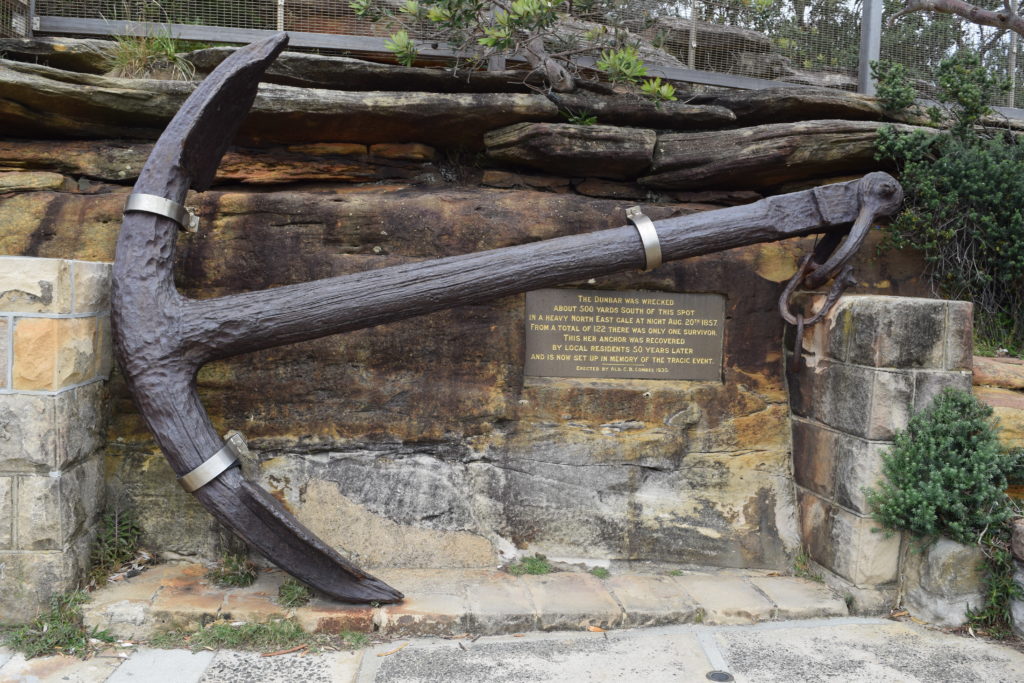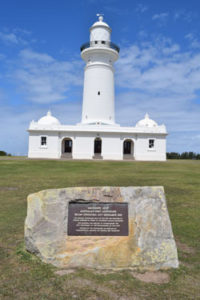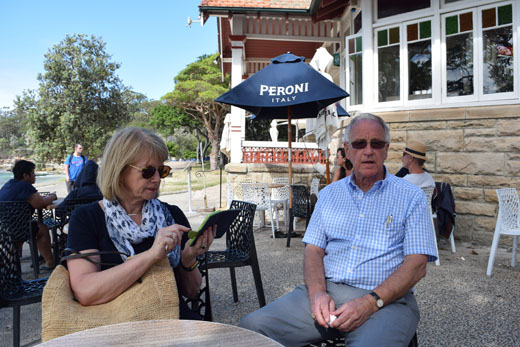This is the fourth in a series of stories developed during Don & Nancy’s golden anniversary trip to Australia and cruise back to San Diego. To read previous stories in the series, please click on their corresponding number: 1, 2, 3.

By Donald H. Harrison
SYDNEY, Australia – There are a number of fascinating places and sights to see around the 12-mile long Sydney Harbor, including its most recognized landmark, the Sydney Opera House. There are such spots as Mrs. McQuairie’s chair, a rock formation carved by convicts, where legend has it the wife of early 19th Century Governor Lachlan Macquarie used to sit for hours scanning the harbor for incoming ships. McMahon’s Point honors an Irish laborer who rose to become mayor of Sydney’s suburb of Victoria, now called North Sydney. And there is Watson’s Bay, named for Robert Watson, who beached some of his vessels to prevent them from being seized. He later became Sydney’s harbormaster and keeper of the MacQuarie Lighthouse.
Our hosts, Philip and Donna Moses, took us to visit them all, but perhaps none of these sites—not even the Sydney Opera House—will remain in my and wife Nancy’s imaginations as firmly as that of the Dunbar Memorial situated at an area of the harbor known as the Gap.

A large anchor is mounted against a rock formation there, with a plaque that bears the following legend:
“The Dunbar was wrecked about 500 yards south of this spot in a heavy north east gale at night Aug. 20th 1857. From a total of 122, there was only one survivor. This her anchor was recovered 50 years later by local residents 50 years later and is now set up in memory of the tragic event.”

Historic sources indicate that the three-masted Dunbar, built at the cost of 30,000 British pounds for owner Duncan Dunbar, weighed 300 tons without passengers and cargo, and was 201 feet long and 30 feet wide. Its hull and frames were of British oak, while it decks were of East India teak. On that fateful voyage, Dunbar carried 59 crew and 63 passengers. First-class accommodations were said to be finely upholstered. One contemporary account of the disaster said the wreckage of the ship was found at a point midway between South Head on which the MacQuarie Lighthouse stands, and South Reef at the entrance of “Port Jackson,” which is another name for Sydney Harbor.
When the Dunbar story is recounted, most attention usually is given to the survivor, James Johnson, an able seaman who was thrown against the rocks and managed to scramble to safety, even as the full-rigged sailing ship was breaking up against the rocky cliffs, powerless against the gale-force winds. It is believed that the ship’s captain, James Green, in the heavy, blinding, storm may have mistaken a small break in the coastline, known today as the Gap, for the entrance to the main harbor, thereby putting his ship in its precarious position from which he could not extricate himself. The tragedy of what was the Dunbar’s second sailing from London to Sydney, still reverberates today, with a memorial service for the victims held every August.
In addition to the tale often told about Johnson’s miraculous survival, there are also the stories of the passengers whose names were listed on the ship’s manifest, a copy of which today is stored in the building containing the New South Wales Records and Archives. Among the passengers were Abraham and Julia Meyers and their six children, a Jewish family that was well off enough to be cabin passengers rather than having to travel in steerage as did many of the other victims.

Julia (Hart) Meyers was the sister of Deborah (Hart) Moses, the latter being our friend Philip’s great-great-grandmother. The Meyers were on the return portion of an 81-day roundtrip between England and Australia. An Australian family, they had been visiting relatives in England. At the same time the family of Philip’s great-great grandfather, Solomon Moses, also had been in England, and the two families visited each other in the “mother country.” Solomon Moses had built the Royal Hotel in Goulburn, Australia, located between Sydney and Canberra.
A letter of Abraham’s, dated June 4th 1856, noted that “Sol & Deborah is [sic] well and Deborah will have an increase in family about Oct. next.” According to an article by Dr. George Bergman in the Australian Jewish News published Aug. 28, 1964, “Rachael Moses was, in fact, born at home in South Lambeth [England] on 14th November 1856.”
Bergman reported that, “It would appear Solomon and Deborah returned to Australia one year later than Abraham and Julia. An entry for Arrivals in Sydney on the ship ‘Speedy’ from London on 31st August 1858, reads “Mr. and Mrs. Moses, 5 sons & 2 daughters, fem serv.”
One wonders what Solomon and Deborah would have thought, perhaps in fear mixed with sad loss, as the ship Speedy made its way past the Gap, where their sister, brother in law, and nieces and nephews had all perished.
Bergman also reported that one Isaac Simmons, described as a “young Jewish man,” also was among the Dunbar victims. He quoted an article in the Sydney Morning Herald that Simmons had traveled to Australia intending “to take possession of his share of the property of his father,” who had died in May 1849.
A funeral procession along George Street of Sydney attracted an estimated 20,000 people on August 24th 1854, while all ships in the harbor flew their flags at half-mast.
Although some of the Dunbar victims subsequently were buried in a mass grave at the Camperdown Cemetery in the Newton suburb of Sydney, Abraham Meyers was one victim whose body never was found, according to Bregman’s article. Other references about the famous shipwreck said that sharks swimming near the Gap fought people who were trying to recover the bodies.
Every August, a memorial ceremony is held at Camperdown for the shipwreck victims. Even if the victims had lived to a ripe age, in all likelihood Philip was born too recently to have known any of them. Nevertheless, as the Honorary Secretary of the Australian Jewish Historical Society, based in Sydney, he has a strong interest in the incident, as does his wife Donna, a longtime social worker attached to local hospitals.
One reason why this story stuck with me was that I reflected that like the biblical Moses, whom God permitted to see the Promised Land from Mount Nebo before his death, the family of Abraham Moses also glimpsed their cherished land before they were swept to eternity.
*
Harrison is editor of San Diego Jewish World. He may be contacted via Donald.harrison@sdjewishworld.com
Pingback: Hakas and Challahs on a Dutch ship | San Diego Jewish World